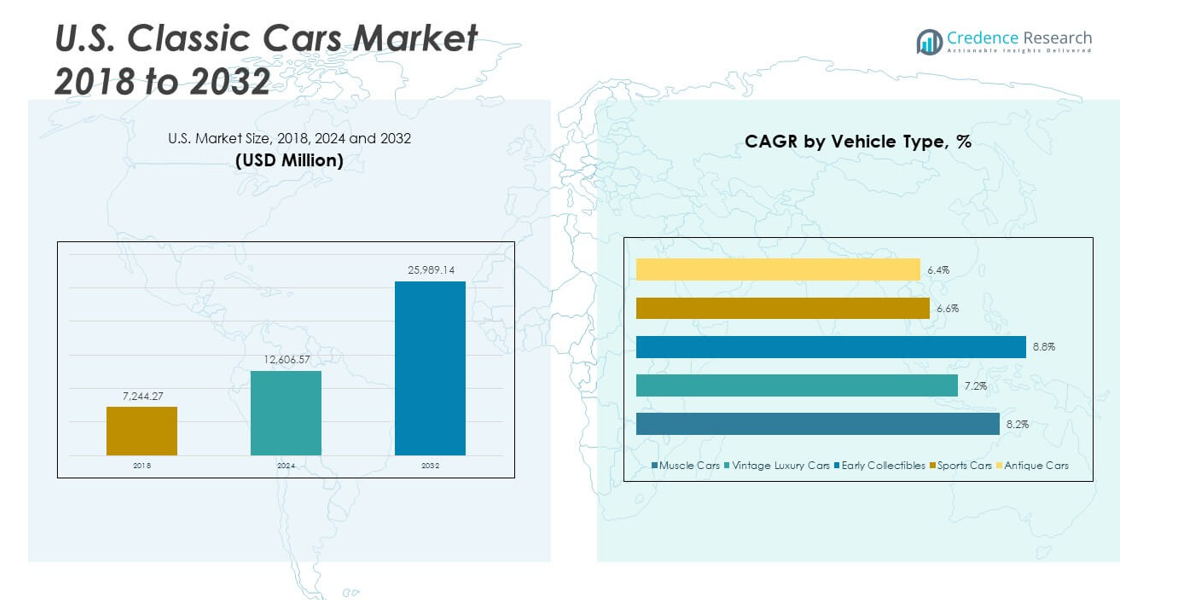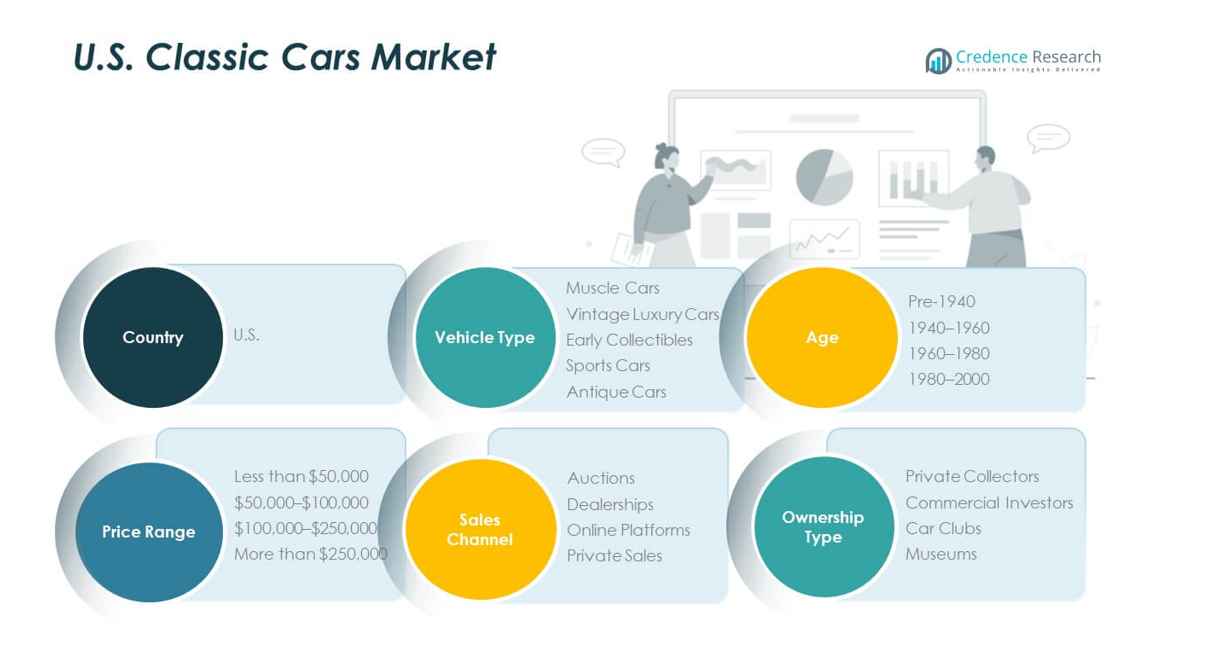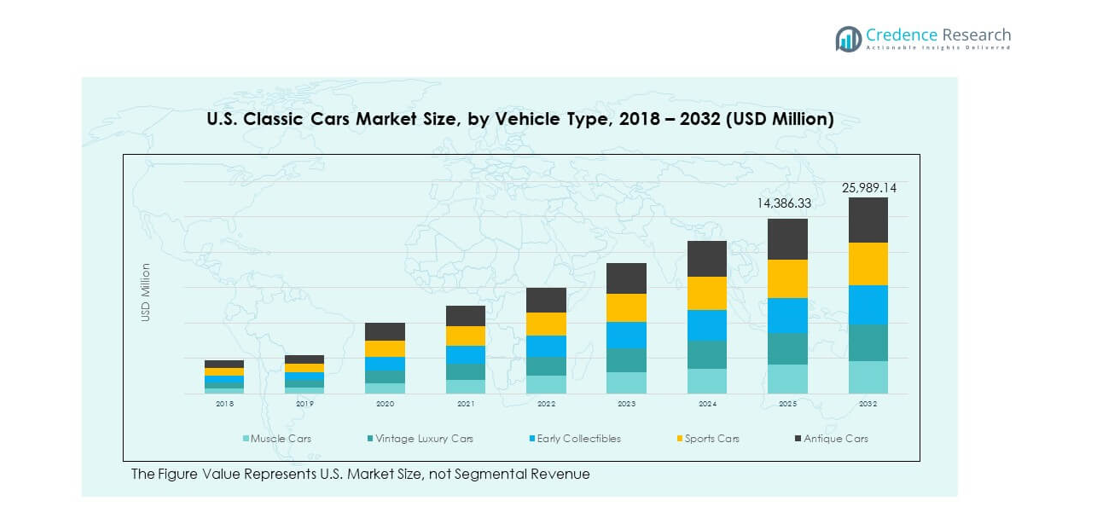CHAPTER NO. 1 : INTRODUCTION 23
1.1. Report Description 23
Purpose of the Report 23
USP & Key Offerings 23
1.2. Key Benefits for Stakeholders 24
1.3. Target Audience 24
CHAPTER NO. 2 : EXECUTIVE SUMMARY 25
CHAPTER NO. 3 : U.S. CLASSIC CARS MARKET FORCES & INDUSTRY PULSE 27
3.1. Foundations of Change – Market Overview 27
3.2. Catalysts of Expansion – Key Market Drivers 29
3.2.1. Momentum Boosters – Growth Triggers 30
3.2.2. Innovation Fuel – Disruptive Technologies 30
3.3. Headwinds & Crosswinds – Market Restraints 31
3.3.1. Regulatory Tides – Compliance Challenges 32
3.3.2. Economic Frictions – Inflationary Pressures 32
3.4. Untapped Horizons – Growth Potential & Opportunities and Strategic Navigation – Industry Frameworks 33
3.5. Market Equilibrium – Porter’s Five Forces 34
3.6. Ecosystem Dynamics – Value Chain Analysis 36
3.7. Macro Forces – PESTEL Breakdown 38
3.8. Price Trend Analysis 40
3.8.1. Price Trend by Type 41
3.9. Buying Criteria 42
CHAPTER NO. 4 : COMPETITION ANALYSIS 43
4.1. Company Market Share Analysis 43
4.1.1. U.S. Classic Cars Market Company Revenue Market Share 43
4.2. Strategic Developments 45
4.2.1. Acquisitions & Mergers 45
4.2.2. New Product Launch 46
4.2.3. Agreements & Collaborations 47
4.3. Competitive Dashboard 48
4.4. Company Assessment Metrics, 2024 49
CHAPTER NO. 5 : U.S. MARKET ANALYSIS, INSIGHTS & FORECAST, BY VEHICLE TYPE 50
CHAPTER NO. 6 : U.S. MARKET ANALYSIS, INSIGHTS & FORECAST, BY AGE 55
CHAPTER NO. 7 : U.S. MARKET ANALYSIS, INSIGHTS & FORECAST, BY PRICE RANGE 60
CHAPTER NO. 8 : U.S. MARKET ANALYSIS, INSIGHTS & FORECAST, BY SALES CHANNEL 65
CHAPTER NO. 9 : U.S. MARKET ANALYSIS, INSIGHTS & FORECAST, BY OWNERSHIP TYPE 70
CHAPTER NO. 10 : U.S. MARKET ANALYSIS, INSIGHTS & FORECAST, BY RESTORATION LEVEL 75
CHAPTER NO. 11 : U.S. MARKET ANALYSIS, INSIGHTS & FORECAST, BY REGION 80
CHAPTER NO. 12 : COMPANY PROFILE 85
12.1. Hemmings Motor News 85
12.2. Mecum Auctions 88
12.3. RM Sotheby’s 88
12.4. Barrett-Jackson 88
12.5. ClassicCars.com 88
12.6. Company 6 88
12.7. Company 7 88
12.8. Company 8 88
12.9. Company 9 88
12.10. Company 10 88
List of Figures
FIG NO. 1. U.S. Classic Cars Market Revenue Share, By Vehicle Type, 2024 & 2032 50
FIG NO. 2. Market Attractiveness Analysis, By Vehicle Type 51
FIG NO. 3. Incremental Revenue Growth Opportunity by Vehicle Type, 2024 – 2032 52
FIG NO. 4. U.S. Classic Cars Market Revenue Share, By Age, 2024 & 2032 55
FIG NO. 5. Market Attractiveness Analysis, By Age 56
FIG NO. 6. Incremental Revenue Growth Opportunity by Age, 2024 – 2032 57
FIG NO. 7. U.S. Classic Cars Market Revenue Share, By Price Range, 2024 & 2032 60
FIG NO. 8. Market Attractiveness Analysis, By Price Range 61
FIG NO. 9. Incremental Revenue Growth Opportunity by Price Range, 2024 – 2032 62
FIG NO. 10. U.S. Classic Cars Market Revenue Share, By Sales Channel, 2024 & 2032 65
FIG NO. 11. Market Attractiveness Analysis, By Sales Channel 66
FIG NO. 12. Incremental Revenue Growth Opportunity by Sales Channel, 2024 – 2032 67
FIG NO. 13. U.S. Classic Cars Market Revenue Share, By Ownership Type, 2024 & 2032 70
FIG NO. 14. Market Attractiveness Analysis, By Ownership Type 71
FIG NO. 15. Incremental Revenue Growth Opportunity by Ownership Type, 2024 – 2032 72
FIG NO. 16. U.S. Classic Cars Market Revenue Share, By Restoration Level, 2024 & 2032 75
FIG NO. 17. Market Attractiveness Analysis, By Restoration Level 76
FIG NO. 18. Incremental Revenue Growth Opportunity by Restoration Level, 2024 – 2032 77
FIG NO. 19. U.S. Classic Cars Market Revenue Share, By Region, 2024 & 2032 80
FIG NO. 20. Market Attractiveness Analysis, By Region 81
FIG NO. 21. Incremental Revenue Growth Opportunity by Region, 2024 – 2032 82
List of Tables
TABLE NO. 1. : U.S. Classic Cars Market Revenue, By Vehicle Type, 2018 – 2024 (USD Million) 53
TABLE NO. 2. : U.S. Classic Cars Market Revenue, By Vehicle Type, 2025 – 2032 (USD Million) 53
TABLE NO. 3. : U.S. Classic Cars Market Volume, By Vehicle Type, 2018 – 2024 (Units) 54
TABLE NO. 4. : U.S. Classic Cars Market Volume, By Vehicle Type, 2025 – 2032 (Units) 54
TABLE NO. 5. : U.S. Classic Cars Market Revenue, By Age, 2018 – 2024 (USD Million) 58
TABLE NO. 6. : U.S. Classic Cars Market Revenue, By Age, 2025 – 2032 (USD Million) 58
TABLE NO. 7. : U.S. Classic Cars Market Volume, By Age, 2018 – 2024 (Units) 59
TABLE NO. 8. : U.S. Classic Cars Market Volume, By Age, 2025 – 2032 (Units) 59
TABLE NO. 9. : U.S. Classic Cars Market Revenue, By Price Range, 2018 – 2024 (USD Million) 63
TABLE NO. 10. : U.S. Classic Cars Market Revenue, By Price Range, 2025 – 2032 (USD Million) 63
TABLE NO. 11. : U.S. Classic Cars Market Volume, By Price Range, 2018 – 2024 (Units) 64
TABLE NO. 12. : U.S. Classic Cars Market Volume, By Price Range, 2025 – 2032 (Units) 64
TABLE NO. 13. : U.S. Classic Cars Market Revenue, By Sales Channel, 2018 – 2024 (USD Million) 68
TABLE NO. 14. : U.S. Classic Cars Market Revenue, By Sales Channel, 2025 – 2032 (USD Million) 68
TABLE NO. 15. : U.S. Classic Cars Market Volume, By Sales Channel, 2018 – 2024 (Units) 69
TABLE NO. 16. : U.S. Classic Cars Market Volume, By Sales Channel, 2025 – 2032 (Units) 69
TABLE NO. 17. : U.S. Classic Cars Market Revenue, By Ownership Type, 2018 – 2024 (USD Million) 73
TABLE NO. 18. : U.S. Classic Cars Market Revenue, By Ownership Type, 2025 – 2032 (USD Million) 73
TABLE NO. 19. : U.S. Classic Cars Market Volume, By Ownership Type, 2018 – 2024 (Units) 74
TABLE NO. 20. : U.S. Classic Cars Market Volume, By Ownership Type, 2025 – 2032 (Units) 74
TABLE NO. 21. : U.S. Classic Cars Market Revenue, By Restoration Level, 2018 – 2024 (USD Million) 78
TABLE NO. 22. : U.S. Classic Cars Market Revenue, By Restoration Level, 2025 – 2032 (USD Million) 78
TABLE NO. 23. : U.S. Classic Cars Market Volume, By Restoration Level, 2018 – 2024 (Units) 79
TABLE NO. 24. : U.S. Classic Cars Market Volume, By Restoration Level, 2025 – 2032 (Units) 79
TABLE NO. 25. : U.S. Classic Cars Market Revenue, By Region, 2018 – 2024 (USD Million) 83
TABLE NO. 26. : U.S. Classic Cars Market Revenue, By Region, 2025 – 2032 (USD Million) 83
TABLE NO. 27. : U.S. Classic Cars Market Volume, By Region, 2018 – 2024 (Units) 84
TABLE NO. 28. : U.S. Classic Cars Market Volume, By Region, 2025 – 2032 (Units) 84










